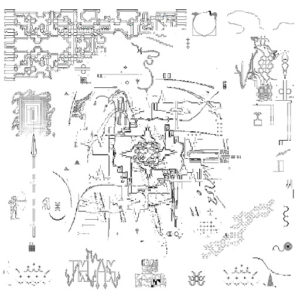 Nicolás Jaar
Nicolás Jaar
Telas
OTHER PEOPLE
8/10
The vast, ethereal sounds of Nicolás Jaar’s latest album, Telas (Spanish for “veils”), are an apt distillation of his progression as a musician: unbound, capricious, and always veiled in mystique. The reclusive Chilean-American artist has dabbled in deconstructed house and techno under his Against All Logic alias, inscrutable dark pop under his own name, and re-scored a 1960’s Soviet art film, among other projects. This is his vibe: the solemn life of the party, erudite and cheeky. Now, on Jaar’s third album of 2020, he attempts his most experimental venture yet: an hour-long ambient record with little concrete structure.
Jaar does a lot with a limited palette on Telas. We’re largely immersed in passages of spacey synth rushes, aquatic keyboards, industrial feedback, and ritualistic chanting. Despite the loose sounds, Jaar still understands how to fabricate a lived-in world from it. There’s a visual version of Telas in its “liquid state,” as Jaar describes it, providing a semi-discernible representation of how it feels to listen to it—like floating among discomforting metallic echoes, suspended in warm amniotic fluid. The sonic experience is comforting, jolting, mind-numbing, and thrilling in equal measures.
The album opens with a sort of red herring; chaotic clangs of unreasonably speedy drumming, yelping wind instruments, and skittering electronic distortion. It’s one of the most indelible, earthbound moments on Telas. It’s almost a shame that the music ascends like a hot air balloon above the more tactile instruments in favor of vaporous electronics.
The second of the four tracks, “Telencima,” creeps to the surface like a meerkat scanning for predators. Buzzing electronic chirps and wisps morph into Jaar’s signature ocean-submerged synth plucks and keyboard taps. Then a sampled, majestic wind instrument levitates and sways like crackling tree branches in the wind. The composition drops a few meters of altitude when bursts of feedback interrupt the serenity, leading us downward to uncertain waters. Cinematic progressions like these grant Telas its unknowable, haunting qualities.
Inevitably, there are drawn-out passages. The closing track “Telallás” largely functions as a staccato cool down. Around thirteen minutes of prickly percussion and electronic stutters bookend the record. Still, while it lacks the drama of Telas’ more daring moments, it’s undeniably well-produced and coherent with the otherworldly sound palette.
In all, Telas continues to prove that few artists do electronic world-building and immersion quite like Nicolás Jaar. Even at an indulgent running time, Jaar has crafted a terrain of gorgeous, eerie soundscapes that bear his unmistakable patina. For any ambient musician, that’s an accomplishment. For him, it’s just his third album in five months.







